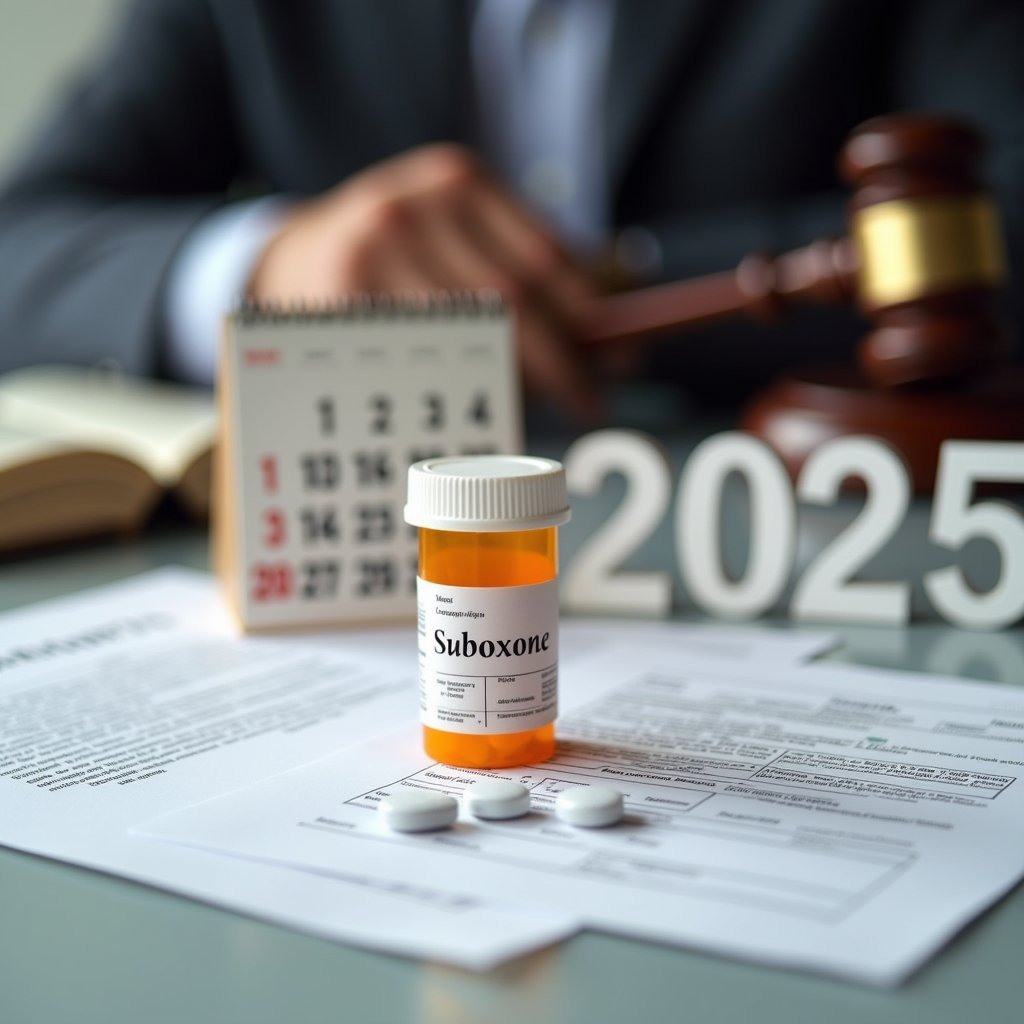If you’re a Suboxone patient in 2025, you’ve got specific legal rights regarding dental injury claims and expanded telemedicine access. You can join the multi-district litigation in Ohio’s Northern District court if you experienced dental problems before June 2022’s label update. Critical deadlines are approaching in June 2025 for many state claims. You’ll need detailed medical records, pharmacy documentation, and provider authorizations within strict timelines. Guaranteeing the full scope of your rights safeguards maximum protection under current regulations.
Understanding Your Legal Rights as a Suboxone Patient

Every Suboxone patient maintains specific legal rights regarding their treatment and potential injuries from the medication. If you’ve experienced dental complications while using Suboxone, you’re entitled to submit adverse event reports and seek compensation for dental healthcare costs. You have the right to join the multidistrict litigation in Ohio, particularly if you used Suboxone before the June 2022 label update. Under the new telemedicine flexibilities, patients can continue receiving remote prescriptions through the end of 2025. The Court has already denied attempts to dismiss claims through federal preemption arguments.
Your rights include pursuing claims for both pre-approval design defects and failure-to-warn issues that survived legal dismissal. You’re eligible to seek damages covering dental restoration costs, medical expenses, lost wages, and compensation for pain and suffering. Legal experts suggest acting quickly as there are currently 896 pending lawsuits in the consolidated litigation. When exercising these rights, you’ll need to document your Suboxone usage history, dental injuries, and related expenses. Consider consulting an attorney specializing in pharmaceutical litigation to protect your interests.
Key Deadlines for Filing Dental Injury Claims

Three critical deadlines govern Suboxone dental injury claims in 2025, with many state statutes of limitations expiring in June. You’ll need to verify your state’s statutory filing deadlines immediately, as courts won’t accept cases filed after these cutoff dates.
The aggregation of Suboxone cases into an MDL has established two additional key dates: March 13, 2025, for Schedule A claims, and January 14, 2025, for the case conference. Patients seeking compensation must prove they used Suboxone for months before experiencing dental problems.
To meet these deadlines, you must guarantee your medical providers release records within their mandated 30-day compliance window. Don’t wait until the last minute providers’ delays could jeopardize your claim. Most patients experienced dental complications like tooth decay and infections after using the medication. Your attorney should monitor record collection and report any non-compliance to the MDL court to protect your legal rights. With currently 896 cases pending in the MDL, the litigation continues to grow as more plaintiffs come forward with dental injury claims.
Documentation Required for Suboxone Lawsuits

You’ll need to compile a detailed timeline of your medical records, including all dental visits, treatments, and documented tooth decay that occurred while using Suboxone Film.
Your pharmacy records must show continuous Suboxone prescription history, including specific formulation details, dosage amounts, and dispensing dates that align with the period of dental injury.
Moreover, you’ll have to obtain signed authorizations from your healthcare providers to release these records within the court-mandated 30-day compliance window. If you reside in certain states with a two-year statute of limitations, ensuring prompt documentation is crucial to preserve your legal rights.
With the court now allowing bulk filing of cases, documentation can be submitted more efficiently for groups of up to 100 plaintiffs at once.
Medical Records Timeline
Medical records requests in Suboxone litigation must adhere to strict timelines, with providers now required to produce documentation within 30 days of receiving authorized requests. You’ll need to guarantee your legal team implements proper record management procedures while maintaining data privacy concerns throughout the collection process.
Your medical documentation must include quarterly drug screenings, consent forms, and complete treatment histories. If providers create barriers or refuse to accept electronic signatures, your attorney can seek court enforcement through sanctions. You won’t need to supply extra identification beyond your signed authorization forms, as courts have streamlined these requirements to accelerate MDL proceedings.
For effective case preparation, you should promptly authorize record releases to avoid delays in bellwether trial scheduling and causation arguments related to your dental injuries. The approach of the FDA label change in June 2025 may trigger additional lawsuits, making timely documentation crucial.
Pharmacy Prescription Documentation
When pursuing a Suboxone lawsuit, proper pharmacy documentation serves as critical evidence to support your claim. You’ll need to guarantee your pharmacy maintains thorough records that comply with both federal guidelines and state-specific requirements, particularly for prescriptions received through telemedicine.
Your pharmacy’s records must show proper identity verification through state/federal ID checks and validation of telemedicine prescription protocols. The final rule has removed special recordkeeping requirements previously proposed. Documentation should include verified PDMP checks and prescriber confirmations, especially when prescription volume thresholds are exceeded. The pharmacy must verify that practitioners have reviewed PDMP data for one year before issuing Schedule III-V controlled substances via telemedicine. Records must track the shift in care delivery and the telemedicine modality used (audio-only vs. audio-video). As of February 2025, patients can receive buprenorphine prescriptions through audio-only visits for up to six months. Remote pharmacy protocols require proof of identity verification at pickup, even for prescriptions initiated through telehealth services.
These records can serve as pivotal evidence in litigation involving prescription misuse or diversion claims.
Navigating Telemedicine Changes and Prescriptions
Under the 2025 telemedicine regulations, you’ll need to understand that your initial six months of Suboxone treatment can be initiated through audio-only visits, but subsequent prescriptions require either in-person or audiovisual evaluations.
You’ll find that state-specific prescribing limits may still apply, even though federal documentation requirements have been simplified and special recordkeeping is no longer mandatory.
Your remote provider must maintain compliance with the new special registration requirements for controlled substance prescribing while ensuring continuous access to treatment through approved telemedicine platforms.
Digital Access Rule Changes
Recent federal regulations have permanently transformed digital access to Suboxone treatment, establishing clearer guidelines for both providers and patients. These changes streamline coordinated care approaches and virtual patient onboarding while maintaining clinical standards.
You can now receive initial Suboxone prescriptions through audio-only consultations, without requiring prior in-person visits. Your provider can prescribe up to a 6-month supply, distributed according to their clinical judgment. You’ll need video or in-person evaluations only after the first 6 months of treatment. Your medical records won’t require special documentation beyond standard controlled substance protocols.
These permanent rules guarantee your access to treatment while protecting your legal rights. They’ve eliminated state-specific restrictions and aligned federal regulations to prevent disruptions in your care delivery.
State-Specific Prescribing Limits
Several state-level regulations create a complex terrain for Suboxone prescribing in 2025, requiring careful navigation of varying requirements across jurisdictions. You’ll need to understand your state’s specific dosage monitoring policies, as six states impose strict limits on both initiation and maintenance doses. While federal guidelines favor clinical judgment over standardized protocols, you must comply with your state’s particular requirements.
Moreover, twelve states or DC require counseling, necessitating participation in mandated sessions, with three states specifying minimum frequency requirements. Concurrently, thirteen states and DC enforce drug testing protocols.
While federal rules now allow six-month prescriptions via telemedicine, your state may have additional restrictions, like South Carolina’s requirement for an established provider relationship before receiving Schedule II/III narcotics through telehealth.
Remote Provider Requirements
While federal regulations now permit six-month Suboxone prescriptions through telemedicine, you’ll need to navigate specific provider requirements for remote prescribing. Your provider experience will vary based on the prescriber’s registration level and specialty certification.
- As an initial step, you can receive care through audio-only consultations, but after six months, you’ll need either in-person visits or audio-visual evaluations
- Your provider must verify your identity during the inaugural consultation and maintain compliance with state-specific proximity requirements
- Your prescriber needs appropriate DEA registration based on the medications prescribed, with additional requirements for Schedule II drugs
- Upon completion of the initial six-month period, your patient experience will include mandatory progress assessments before prescription renewals, which can be conducted via audio-visual platforms or in-person visits
Current Status of Multi-District Litigation
As the Suboxone Multi-District Litigation (MDL No. 3092) continues to expand in the Northern District of Ohio, Judge Philip Calabrese now oversees 896 pending cases with an unprecedented surge of 142 new filings since January 2025. This rapid growth presents significant consolidation challenges and demands creative caseload management solutions.
You’ll see increased urgency in filing as three-year statute of limitations deadlines approach in several states, with over 100 new cases expected by summer 2025. The court’s approval of streamlined mass filings allows up to 100 plaintiffs per complaint, helping manage the influx efficiently. The key evidence centers on the drug’s low pH levels causing extensive dental damage to patients.
While bellwether trials are scheduled for later this year, there’s no official settlement framework yet. These test cases will likely influence future settlement discussions and compensation structures.
Dental Damage Evidence and Medical Records
The scientific documentation of Suboxone-related dental damage requires thorough medical records and clinical evidence to establish causation in litigation. Your case strength depends on expansive dental documentation showing how saliva production issues and localized acid exposure led to tooth decay during Suboxone treatment.
Dental records must demonstrate diagnoses of caries, enamel erosion, or gum disease that correlate with your Suboxone prescription timeline. Clinical tests showing reduced saliva flow and acidic pH levels under the tongue strengthen causation arguments. X-rays and imaging that document progressive tooth deterioration serve as objective evidence. Treatment histories should link dental procedures and repairs directly to damage sustained during Suboxone therapy. The sublingual film delivery method of Suboxone contributes significantly to dental complications by prolonged contact with oral tissues.
You’ll need these records to establish the connection between your dental injuries and Suboxone use, supported by current research showing heightened adverse event rates among users. The 305 reported cases of dental problems, including severe damage requiring extensive treatment, demonstrate the widespread nature of this issue.
Impact of New DEA Regulations on Treatment
New DEA regulations in 2025 have fundamentally transformed Suboxone treatment access through expanded telemedicine provisions. You’ll now have access to 6-month prescriptions via telehealth consultations, reducing opioid use disorder stigma and eliminating unnecessary in-person visits.
| Access Component | Previous Rules | New Rules (2025) |
|---|---|---|
| Initial Visit | In-person only | Telehealth allowed |
| Supply Duration | 30 days max | Up to 6 months |
| Refill Process | Monthly visits | Flexible scheduling |
| Provider Requirements | Limited scope | Expanded authority |
While telehealth access challenges persist in rural areas, you’re protected by permanent regulations that enable continuous treatment. Your provider must maintain DEA registration and complete annual training, but you’ll benefit from flexible care options combining telemedicine and in-person visits based on your needs. These changes substantially improve your ability to maintain consistent, legally-compliant treatment.
Settlement Expectations and Compensation
Settlement forecasts for Suboxone-related dental injury claims point to potential compensation ranging from $25,000 to $150,000+ per plaintiff, with payouts expected to begin mid-2025. Financial projections depend heavily on injury severity factors, including documented dental damage, medical expenses, and non-economic impacts.
Your compensation will be individually calculated based on specific dental injuries, treatment costs, and quality of life impacts. You’ll benefit from MDL consolidation, allowing grouped filings of up to 100 plaintiffs per complaint. Your case timing is critical, with defendants citing June 2025 statute of limitations. You should expect compensation to reflect both economic damages (medical costs) and non-economic losses (pain and suffering).
While settlements haven’t been finalized, pre-trial proceedings continue progressing toward anticipated mid-2025 resolutions.
Changes in Warning Labels and Patient Safety
Significant warning label changes for Suboxone products in 2024-2025 have reshaped patient safety protocols and legal obligations. You’ll now find explicit warnings about oral health protections, including risks of tooth decay, gum disease, and tooth loss that weren’t disclosed for nearly two decades after approval.
The FDA’s 2024 labeling revisions have eliminated rigid “target dose” language, acknowledging that long term treatment challenges require versatile dosing above 24mg/day for some patients. You’re now advised to get regular dental checkups and fluoride treatments as part of your treatment protocol. These updates stem from FDA’s review of adverse event reports and SAMHSA listening sessions, resulting in more thorough patient safety guidelines that integrate overdose prevention strategies with individualized dosing recommendations.
Steps to Protect Your Legal Interests
You’ll need to establish a clear record of your medical history by obtaining extensive documentation from all providers who’ve treated your Suboxone-related dental issues. Your records should include detailed pharmacy logs showing Suboxone prescriptions, dental treatment timelines, and clinical assessments demonstrating the progression of oral health problems.
To preserve your legal rights, you should promptly consult an attorney experienced in pharmaceutical litigation who can evaluate your case and safeguard compliance with MDL No. 3030 filing requirements.
Document Medical History Carefully
Proper documentation of your medical history serves as a fundamental foundation for protecting your legal interests in Suboxone-related dental claims. You’ll need to maintain extensive records that establish treatment timeline corroboration and secure dental professional verification of your condition.
Keep detailed logs of your Suboxone usage, including dosage amounts and administration times, alongside pharmacy receipts for proof of purchase.
Document your dental health progression through regular checkups, noting any changes that occurred after starting Suboxone.
Obtain and preserve all dental records, including x-rays and treatment notes that demonstrate the timeline of dental deterioration.
Request written statements from your dental professionals specifically addressing the connection between your Suboxone use and subsequent dental damage.
Maintain copies of all submitted authorizations and provider communications to support your legal claim.
Get Records From Providers
Building on your documented medical history, obtaining complete records from all healthcare providers represents a key step in safeguarding your legal interests. Submit standardized HIPAA-compliant authorization forms with electronic signatures through your providers’ patient record portal. Providers must produce records within 30 days of receiving your authorization.
Don’t accept unnecessary delays or demands for supplemental documentation. Track response timelines carefully through digital record management systems and preserve all correspondence. If providers miss deadlines or create obstacles, report violations to your legal representative immediately.
Pay special attention to dental and pharmacy records, which often require persistent follow-up. Remember, providers face court-ordered mandates and potential contempt charges for non-compliance, so assert your right to timely record production under Rule 45 requirements.
Contact Legal Representation Early
Securing qualified legal representation stands as the essential initial stage for Suboxone users seeking to safeguard their interests in 2025’s legal panorama. Early legal action guarantees you’ll meet critical deadlines while specialized legal representation enhances your potential for compensation.
Contact attorneys with proven experience in Suboxone litigation and pharmaceutical MDLs to evaluate your case’s strength and eligibility. Schedule consultations before approaching deadlines to allow time for thorough evidence collection and claim preparation.
Confirm your attorney’s understanding of dental injury cases and their track record with similar pharmaceutical settlements. Partner with legal counsel who maintains active involvement in the Suboxone MDL proceedings and stays current with evolving case developments.
Taking prompt action through qualified legal channels protects your rights while positioning your case ideally within the MDL framework.
Frequently Asked Questions
Can I Switch to Alternative Medications While Involved in a Suboxone Lawsuit?
You can switch to alternative treatment options while maintaining your lawsuit, but you must properly document this change. Inform your attorney immediately and guarantee your healthcare provider records the shift in your medical records documentation.
Keep following prescribed treatment protocols and don’t switch medications without medical supervision. Recall that changing to pills or other alternatives won’t void your existing case if you’ve already filed, but proper documentation is essential.
How Will Ongoing Suboxone Litigation Affect Insurance Coverage for Current Patients?
You may experience evolving regulatory policies affecting your insurance coverage as litigation progresses. Potential reimbursement changes could include stricter prior authorization requirements, higher copays, or supplementary documentation for Suboxone prescriptions.
Your insurer might require strengthened dental screenings or implement new coverage limitations. You’ll likely see increased scrutiny of claims related to Suboxone treatment, so it’s crucial to maintain detailed medical records and stay informed about your policy changes.
What Happens if My Prescribing Doctor Retires During the Lawsuit?
If your prescribing doctor retires during your lawsuit, you’ll still have legal access to your medical records. Prescriber responsibility doesn’t end with retirement they’re required to maintain or properly transfer your records.
Your legal team can obtain documentation through court orders, HIPAA authorizations, or the facility that inherited your records. If needed, you can rely on pharmacy records, affidavits from your retired doctor, or expert testimony to support your case.
Are International Suboxone Users Eligible to Join U.S. Lawsuits?
You’ll likely face significant challenges joining U.S. Suboxone lawsuits as an international user due to legal jurisdiction complications. Unless you received prescriptions or dental treatment within the U.S., you probably won’t qualify for current litigation.
International policy disparities in drug regulation and warning requirements create supplementary barriers. Your best option is consulting a U.S.-based attorney to evaluate if you have qualifying U.S. connections that could establish standing in American courts.
Can Family Members File Claims for Deceased Suboxone Patients?
Yes, you can file wrongful death claims if you’re a qualifying family member (spouse, child, or dependent) of a deceased Suboxone patient. You’ll need to demonstrate clear civil liability concerns by linking Suboxone use to the death through medical documentation and expert testimony.
You must file within your state’s statute of limitations and prove your eligibility as a dependent through financial records showing support from the deceased.







